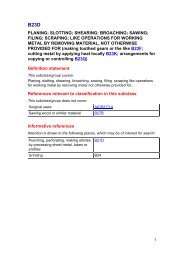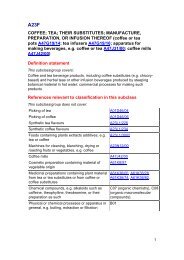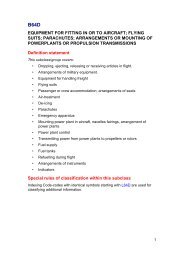A61K - Cooperative Patent Classification
A61K - Cooperative Patent Classification
A61K - Cooperative Patent Classification
You also want an ePaper? Increase the reach of your titles
YUMPU automatically turns print PDFs into web optimized ePapers that Google loves.
CPC - <strong>A61K</strong> - 2013.07 - page 70<br />
-<br />
the carrier being an organic macromolecular compound, i.e. an<br />
oligomeric, polymeric, dendrimeric molecule (not being a peptide,<br />
protein, polyamino acid (see <strong>A61K</strong> 49/00 or <strong>A61K</strong> 14/00 ) or an<br />
antibody (see <strong>A61K</strong> 49/00 or <strong>A61K</strong> 16/00 )<br />
<strong>A61K</strong> 49/122 . . . . . { dimers of complexes or complex-forming compounds }<br />
<strong>A61K</strong> 49/124 . . . . . { dendrimers, dendrons, hyperbranched compounds }<br />
NOTE<br />
-<br />
Said compounds are either complexes or complex-forming<br />
compounds, or they form a backbone to which MRI active nuclei are<br />
complexed or covalently linked through chelating groups. In that<br />
latter case, the subgroup <strong>A61K</strong> 49/085 being also given.<br />
Dendrimeric, dendronised or hyperbranched polyamino acids used<br />
as carriers are also classified in <strong>A61K</strong> 49/146<br />
<strong>A61K</strong> 49/126 . . . . . { Linear polymers, e.g. dextran, inulin, PEG }<br />
<strong>A61K</strong> 49/128 . . . . . . { comprising multiple complex or complex-forming groups, being either<br />
part of the linear polymeric backbone or being pending groups<br />
covalently linked to the linear polymeric backbone }<br />
<strong>A61K</strong> 49/14 . . . . Peptides, e.g. proteins<br />
NOTE<br />
-<br />
In that latter case, classification is also made in <strong>A61K</strong> 49/085<br />
NOTE<br />
-<br />
the carrier being a peptide (polyamino acid, <strong>A61K</strong> 49/14 T) or protein<br />
(not an antibody, see <strong>A61K</strong> 49/16 ). If the MRI-active nucleus being<br />
linked to the peptide or protein or polyamino acid via a complexing or<br />
chelating group, the subgroup <strong>A61K</strong> 49/085 should also be given. If the<br />
peptide or protein or polyamino acid being a dendrimer, a dendron, or<br />
hyperbranched, then the <strong>A61K</strong> 49/124 being also given<br />
<strong>A61K</strong> 49/143 . . . . . { the protein being an albumin, e.g. HSA, BSA, ovalbumin }<br />
<strong>A61K</strong> 49/146 . . . . . { the peptide being a polyamino acid, e.g. poly-lysine }<br />
<strong>A61K</strong> 49/16 . . . . . Antibodies ; Immunoglobulins ; Fragments thereof<br />
NOTE<br />
-<br />
the protein being an antibody, an immunoglobulin or a fragment<br />
thereof. If the MRI-active nucleus being linked to the antibody via a<br />
complexing or chelating group, the subgroup <strong>A61K</strong> 49/085 should<br />
also be given<br />
<strong>A61K</strong> 49/18 . . characterised by a special physical form, e.g. emulsions, microcapsules, liposomes<br />
NOTE<br />
-<br />
<strong>Classification</strong> being also made according to the molecule complexing or





